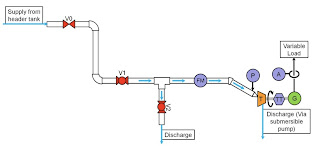For the last month I have been working in our Hydrolab installing the turbine and the associated pipework. I'm not the best at installing things, but I'm quite pleased with the pipe run. I've fitted the system onto the downpipe from a tank 40ft (12.5m) above the lab. The plan of the pipe is in the drawing below:
Plan for pipe installation
I made a series of brackets with Unistrut and Dexion metal frames to support the pipe. I cut the pipe and assembled it dry to make sure that everything fitted before gluing everything together. The PVC pipe glue stinks. It is the most awful smell, even in the large space of the Hydrolab. After a day of gluing pipes together I had a really bad headache, but everything fitted as planned. There were a couple of problems where the glue dried before I could get the pipe to fit snuggly into the fittings, but I managed to adjust some of the brackets to allow for the slight changes in length.
The next step was to silicon up the joints to make them watertight, before checking the pipework for leaks by putting water through the system. There are several valves between my pipe run and the 40ft tank supply. One of them had been shut for a long time, and would not open. Myself and the lab technician, Jack, spent 2 days soaking the valve in WD40, heating it up and hitting it with a large hammer. Finally it cracked open and we were able to pressurise the pipework. There were just 4 small leaks in the pipe, which I was quite impressed with.
Pipework
After plugging the leaks and allowing the silicon to dry off we did another leak check, and the leaks were pretty much sealed - just a couple of small drops of water were coming out. So, now was the moment of truth. Connecting everything together to see if the turbine would work. The last year has really come down to this, the choice of turbine and design of the rig - what would happen if it didn't work. I hadn't really thought about that. I connected up the turbine to the flexible pipe from the end of the pipe run, switched on the oscilloscope to look at the output from the torque transducer and current sensor (used to measure the speed of rotation of the turbine) and then slowly cracked open the control valve.
With a rushing of water, the pipes slowly filled with water and the nozzle pressurised. Finally the nozzle exploded into life, directing water at the turbine, and the turbine began to spin. Across on the oscilloscope a trace was visible from the current and the torque. The excess water fell into the little water tank and then was pumped away by a little submersible pump. The only real problem was that the tank obviously wasn't up to the task that I required of it, water splashed out and all over the Hydrolab floor. But it worked! A video and a couple of photos of the first run can be seen below.
Turbine running with the water splashing
Oscilloscope trace (top torque, lower - current)
Video of first run
So now, the testing begins, and trying to match the model and test results…
Last year I displayed a poster at the EWB research conference. This year, I was asked to present a paper on the Energy Panel about my work so far. This will be in the beginning of March at the Royal Academy of Engineering, London. So I spent a couple of days writing a paper to describe the work I've been doing. I'm looking forward to the conference, to get feedback on the work I've done so far and see what people think about the direction I've gone it, especially as it will be the first time I'm presented my work to people outside the university.
I received comments on the WREC paper I submitted before Christmas. Most of the comments were insignificant, and we got a great score on the paper. This was fantastic, and after a couple of small alterations to the paper, I resubmitted it again. I should hear back about the paper in the middle of February, whether it's been accepted or not.
It's going to be a fun couple of months, finally getting some testing to do!
SAM




